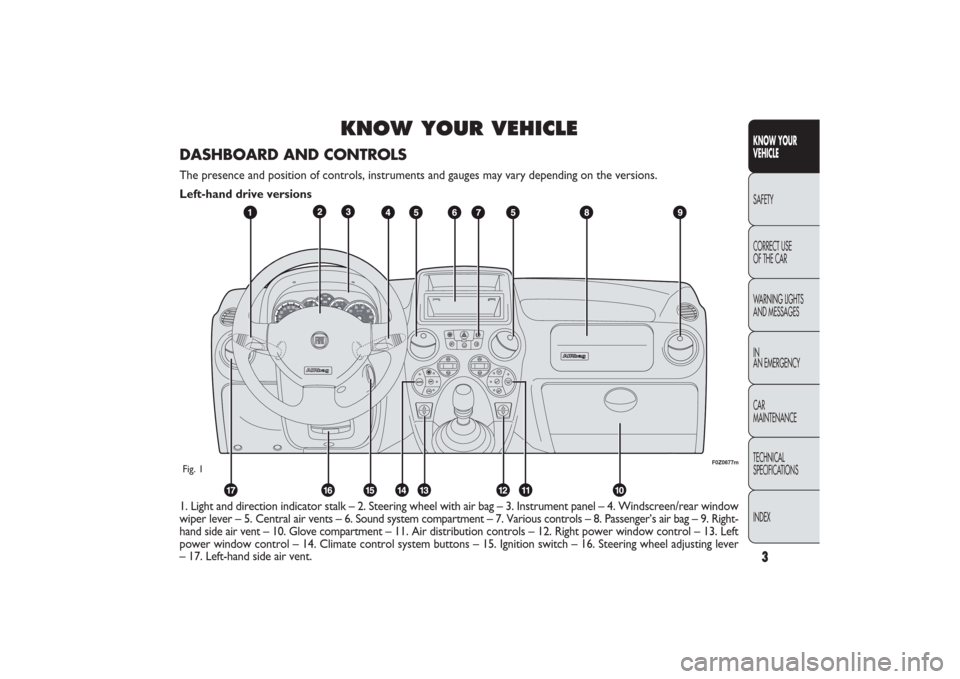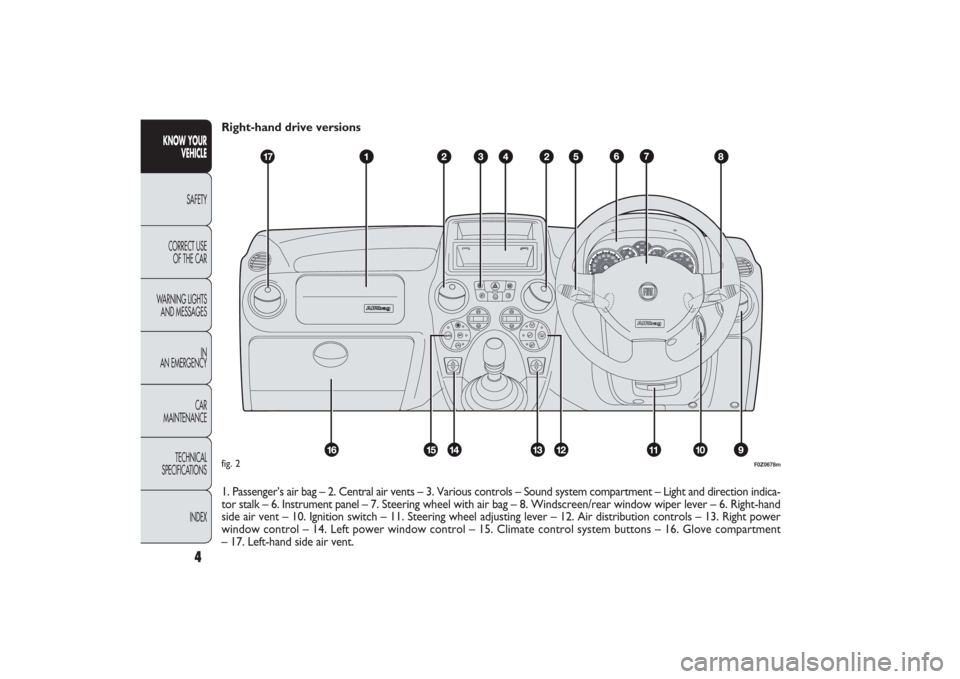2009 FIAT PANDA windscreen
[x] Cancel search: windscreenPage 4 of 226

3KNOW YOUR
VEHICLESAFETY
CORRECT USE
OF THE CAR
WARNING LIGHTS
AND MESSAGES
IN
AN EMERGENCY
CAR
MAINTENANCE
TECHNICAL
SPECIFICATIONS
INDEX
KNOW YOUR VEHICLE
1. Light and direction indicator stalk – 2. Steering wheel with air bag – 3. Instrument panel – 4. Windscreen/rear window
wiper lever – 5. Central air vents – 6. Sound system compartment – 7. Various controls – 8. Passenger’s air bag – 9. Right-
hand side air vent – 10. Glove compartment – 11. Air distribution controls – 12. Right power window control – 13. Left
power window control – 14. Climate control system buttons – 15. Ignition switch – 16. Steering wheel adjusting lever
– 17. Left-hand side air vent.
F0Z0677m
Fig. 1DASHBOARD AND CONTROLSThe presence and position of controls, instruments and gauges may vary depending on the versions.
Left-hand drive versions
001-030 PANDA EN 7-10-2009 13:39 Pagina 3
Page 5 of 226

4
KNOW YOUR
VEHICLE
SAFETY
CORRECT USE
OF THE CAR
WARNING LIGHTS
AND MESSAGES
IN
AN EMERGENCY
CAR
MAINTENANCE
TECHNICAL
SPECIFICATIONS
INDEX
Right-hand drive versions
1. Passenger’s air bag – 2. Central air vents – 3. Various controls – Sound system compartment – Light and direction indica-
tor stalk – 6. Instrument panel – 7. Steering wheel with air bag – 8. Windscreen/rear window wiper lever – 6. Right-hand
side air vent – 10. Ignition switch – 11. Steering wheel adjusting lever – 12. Air distribution controls – 13. Right power
window control – 14. Left power window control – 15. Climate control system buttons – 16. Glove compartment
– 17. Left-hand side air vent.
CH
F
E
F0Z0678m
fig. 2
001-030 PANDA EN 7-10-2009 13:39 Pagina 4
Page 36 of 226

35KNOW YOUR
VEHICLESAFETY
CORRECT USE
OF THE CAR
WARNING LIGHTS
AND MESSAGES
IN
AN EMERGENCY
CAR
MAINTENANCE
TECHNICAL
SPECIFICATIONS
INDEX
F0Z0036m
fig. 37
F0Z0744m
fig. 38
REAR VIEW MIRRORSINTERIOR MIRROR fig. 37
The mirror is fitted with a safety device that causes
its release in the event of a violent impact with the
passenger.
The mirror can be adjusted to two different positions
(normal or antiglare) by means of the lever A.BABY SURVEILLANCE MIRROR fig. 38
(for versions/markets where provided)
The surveillance mirror gives the driver and passenger an
overview of rear seats, to keep under control all passen-
gers (children) on the rear seats.
The mirror must be fasted to the windscreen using the rel-
evant sucker. Warning: to preserve visibility, the surveil-
lance mirror can only be positioned according to fig. 38,
over a parallel line to the roof trim, at about 11 cm. Do not
place the mirror on printed areas, as it could easily detach.
This is not a toy and should be kept far from children’s
reach.
031-064 PANDA EN 7-10-2009 13:43 Pagina 35
Page 38 of 226

37
HEATING AND VENTILATION
fig. 41
1. Vent for windscreen defrosting or demisting – 2. Adjustable central vent – 3. Side adjustable vent – 4. Fixed side
vent to convey air to side windows – 5. Side vents to convey air to front seat passengers’ feet – 6. Side vents to
convey air to rear seat passengers’ feet.
KNOW YOUR
VEHICLESAFETY
CORRECT USE
OF THE CAR
WARNING LIGHTS
AND MESSAGES
IN
AN EMERGENCY
CAR
MAINTENANCE
TECHNICAL
SPECIFICATIONS
INDEX
F0Z0023m
fig. 42
C
I
TY
F0Z0024m
fig. 43
F0Z0685m
fig. 41
ADJUSTABLE SIDE AND CENTRAL VENTS
fig. 42 – 43
A Fixed vent for side window.
B Adjustable side vents.
C Adjustable central vents.
To use vents B and C press them as shown by the arrow
and adjust them as required (they can be rotated to what-
ever direction).
031-064 PANDA EN 7-10-2009 13:43 Pagina 37
Page 39 of 226

F0Z0022m
fig. 44
It is advisable to switch the internal air recirculation on while
standing in queues or in tunnels to prevent the introduc-
tion of polluted air. However, it is better not to use the
function for long periods, particularly if there are many peo-
ple on board, to prevent the windows from misting inside.
IMPORTANT The inside air recirculation system makes it
possible to reach the required heating or cooling condi-
tions faster. Do not use the air recirculation function on
rainy/cold days as it would considerably increase the pos-
sibility of the windows misting inside.
Air distribution knob
D
¥
to convey air to the central and side vents;
μ
to send air to the feet and convey cooler air to
the dashboard vents, in intermediate temperature
conditions;
w
to heat with outside harsh temperature: close central
and side vents to convey as much air as possible to
the feet;
≤to warm the feet and, at the same time, demist the
windscreen;
-
for quick windscreen demisting. CONTROLS fig. 44
Air temperature knob A (mixing hot/cold air)
Red section = hot air
Blue section = cold air
Fan activation/adjustment knob B
0 = fan off
1-2-3 = fan speed
-
= maximum fan speed
Air recirculation on/off knob
C
U
= outside air intake
T
= inside air recirculation
38
KNOW YOUR
VEHICLE
SAFETY
CORRECT USE
OF THE CAR
WARNING LIGHTS
AND MESSAGES
IN
AN EMERGENCY
CAR
MAINTENANCE
TECHNICAL
SPECIFICATIONS
INDEX
031-064 PANDA EN 7-10-2009 13:43 Pagina 38
Page 42 of 226

41KNOW YOUR
VEHICLESAFETY
CORRECT USE
OF THE CAR
WARNING LIGHTS
AND MESSAGES
IN
AN EMERGENCY
CAR
MAINTENANCE
TECHNICAL
SPECIFICATIONS
INDEX
Air recirculation on/off knob CU
= outside air intake
T
= inside air recirculation
It is advisable to switch the internal air recirculation on while
standing in queues or in tunnels to prevent the introduc-
tion of polluted air. However, it is better not to use the
function for long periods, particularly if there are many peo-
ple on board, to prevent the windows from misting inside.
IMPORTANT The inside air recirculation system makes it
possible to reach the required heating or cooling condi-
tions faster. Do not use the air recirculation function on
rainy/cold days as it would considerably increase the pos-
sibility of the windows misting inside.
Air distribution knob D
¥
air flow from central vents and side vents;
μ
to warm the feet and keep the face cool (“bilevel”
function);
w
to speed up passenger compartment warming;
≤to warm the passenger compartment and at the same
time demist the windscreen;
-
to demist and defrost the windscreen and front side
windows.
MANUAL CLIMATE CONTROL
SYSTEM(for versions/markets where provided)
CONTROLS fig. 46
Air temperature knob
A(mixing hot/cold air)
Red section = hot air
Blue section = cold air
Fan activation and climate control system on/off
knob B
0 = fan off
1-2-3 = fan speed
-
= maximum fan speed
Press the knob to turn the climate control system on, the
LED on the knob will turn on. Press it again to turn it off,
the LED will turn off.
F0Z0600m
fig. 46
031-064 PANDA EN 7-10-2009 13:43 Pagina 41
Page 43 of 226

Then use the controls to keep the required comfort con-
ditions and turn the knob
Cto
U
.
IMPORTANT With cold engine, you have to wait for
a few minutes to let the system fluid reach the operating
temperature.
WINDSCREEN AND FRONT SIDE WINDOW
FAST DEMISTING/DEFROSTING
(MAX-DEF function)
Proceed as follows:
❒
turn the knob A to the red sector;
❒
turn the knob C to
U
;
❒
turn the knob D to
-
;
❒
turn the knob B to
-
(maximum fan speed).
After demisting/defrosting, operate the controls to keep
the required comfort conditions.
IMPORTANT The climate control system is very useful to
speed up demisting since it dehumidifies the air. Adjust the
controls as described above and press knob B to switch
the climate control system on: the LED on the knob will
light up. PASSENGER COMPARTMENT VENTILATION
To ventilate the passenger compartment properly, pro-
ceed as follows:
❒
fully open the central and side air vents;
❒
turn the knob A to blue sector;
❒
turn the knob C to
U
;
❒
turn the knob D to
¥;
❒
turn the knob B to the required speed.
PASSENGER COMPARTMENT HEATING
Proceed as follows:
❒
turn the knob A to the red sector;
❒
turn the knob D to the required symbol;
❒
turn the knob B to the required speed.
FAST PASSENGER COMPARTMENT HEATING
For the fast heating of the passenger compartment, pro-
ceed as follows:
❒
turn the knob A to the red sector;
❒
turn the knob C to
T
;
❒
turn the knob D to
-
;
❒
turn the knob B to
-
(maximum fan speed).
42
KNOW YOUR
VEHICLE
SAFETY
CORRECT USE
OF THE CAR
WARNING LIGHTS
AND MESSAGES
IN
AN EMERGENCY
CAR
MAINTENANCE
TECHNICAL
SPECIFICATIONS
INDEX
031-064 PANDA EN 7-10-2009 13:43 Pagina 42
Page 47 of 226

μ
air flow towards the front seat feet area. Due to the
natural tendency of heat to spread upwards, this type
of distribution warms the passenger compartment
up as quickly as possible, providing an immediate
feeling of warmth.
w+μ
distribution between feet area vents (warmest air)
and dashboard vents (coolest air).
¥+μ
distribution between feet area vents and wind-
screen/side front window vents. This type of distri-
bution achieves an adequate warming of the pas-
senger compartment and prevents the windows
from misting up.
The set air distribution is shown by the LEDs on the
selected buttons.
To restore the automatic air distribution control, press
the AUTO button.
During automatic operation, under particular climate con-
ditions, the system can send air to the windscreen although
the relevant LED does not turn on.
Button
-
- L
Fast front window demisting/defrosting
Pressing the button
-
the system activates all the functions
required for fast demisting/defrosting, that is:
❒
compressor switching-on (if the weather conditions are
suitable);
❒
air recirculation switching-off;
❒
maximum air temperature setting (HI); IMPORTANT If the heating fluid is not sufficiently hot, max-
imum fan speed will not be activated immediately to pre-
vent air not warm enough from entering the passenger
compartment.
LO function
This function can be switched on to cool the passenger
compartment as quickly as possible; with this function
switched on the compressor will be engaged whereas air
distribution and fan speed are controlled by the system.
To turn this function off, set the required temperature.
IMPORTANT With the function switched on, however, all
the manual settings can be made.
Buttons
ÕÔ
– F
Fan speed adjustment
Pressing the buttons
Õ
or
Ôrespectively, the fan speed
shown on the display bars increases or decreases.
The fan can be cut off only if the compressor has been
switched off (B button).
To restore automatic fan speed control, press the
AUTO
button.
Buttons
¥wμ
– G H I
Air distribution manual selection
Pressing the buttons, one of the five possible air flow
distribution patterns can be selected:
¥
air flow to the windscreen and front side window
vents to demist or defrost them.
w
air flow to the central and side dashboard vents to ven-
tilate the chest and the face during the hot season.
46
KNOW YOUR
VEHICLE
SAFETY
CORRECT USE
OF THE CAR
WARNING LIGHTS
AND MESSAGES
IN
AN EMERGENCY
CAR
MAINTENANCE
TECHNICAL
SPECIFICATIONS
INDEX
031-064 PANDA EN 7-10-2009 13:43 Pagina 46